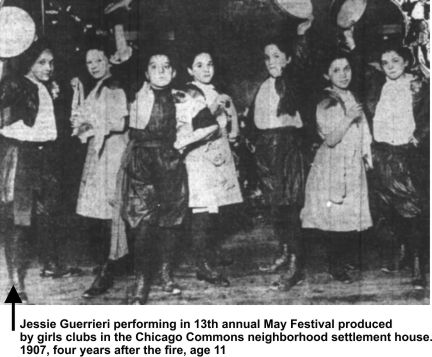|

|
The Chicago Commons settlement house was founded by German immigrants.
Participation by the Italian Guerrieri family may have resulted in part from
Ralph Guerrieri's employer, Ernest Kruetgen, who was active in Chicago's German
immigrant community. The sixth girl from right is Rosia Guerrieri, thought
to be a cousin, daughter of Nick Guerrieri.
On December 30, 1903,
four children from the Guerrieri family attended an afternoon
matinee of Mr. Bluebeard at Chicago's newest playhouse,
the Iroquois Theater on Randolph St. They had standing
space in one of the balconies. When a stage fire spread to
the auditorium, one of the Guerrieri's joined nearly six hundred
fatalities. Two others in the
Guerrieri party were badly injured.
|
|
|
Magdalena Garramone Guerrieri (1860–1926 ) and Giovanni "John" Guerrieri (1853–1927)
had married in 1884 and emigrated
from the Brindisi area in southern Italy to America
in 1891. Magdalena gave birth to nine children but
by 1910 only five survived. In 1903 the family
lived at 135 North Sangamon in Chicago, about four
blocks from the Iroquois Theater.
In the Guerrieri Iroquois Theater party:
-
Anna B. Millikin (or Milliken) survivor of unknown relationship to the Guerrieri family, burned on face and hands
-
Eleven-year-old Vingenzia "Jennie "Guerrieri (b. 1892), fatality
-
Seventeen-year-old Raphael Felix "Ralph" Guerrieri (1886–1956), injured survivor
-
Ten-year-old Anthony "Tony" Guerrieri (1893–1960), survivor
-
Seven-year-old Celestina "Jessie" Guerrieri (1896–1972), injured survivor
Jessie and Raphael were both seriously
injured at the Iroquois and taken to St. Lukes
hospital.
Jennie Guerrieri had attended the Moses Montefiore school.
Reportedly found suffocated beneath a pile of other
bodies, her body was identified by her older
brother, Michael Guerrieri. She was buried in
Chicago's Calvary Cemetery.
Ralph Guerrieri's ears and hands were badly burned while
trying to save his siblings, his hands remaining crippled enough that it was cited as a disability on
his WWI draft registration over a decade after the
fire. He was nevertheless able to work as a commercial artist and did so from at
least 1910 to 1930. In 1917 he worked for the Ernest
J. Kreutgen Engraving company at 626 Federal Street.
(Kreutgen would go on to become the Chicago
postmaster.)
|

|
According to his WWI draft registration, Ralph had black hair, blue eyes and was stout. In his early
forties he married a woman named Mary. A descendent reports that he wore his hair long
throughout his life so as to cover the burns on his ears.
As an adult, Tony Guerrieri worked off and on in the garment industry,
sometimes as a tailor, other times as a cutter.
He also tried his hand at sales, working for a
confectionary company. He married Jessamine Isso and had two daughters.
Jessie Guerrieri married Nicholas Colucci and they had two sons,
Victor and John.
Anna B. Millikin (or Milliken) lived at the Thompson's European Hotel at 151 Dearborn
street. That's all that was reported about the
woman. The hotel was owned by John R. Thompson of Thompson's diners. Newspapers and
the Marshall disaster book published an inaccurate description of
the Guerrieri party experience, identified as a quotation from Millikin (below), that she was likely
dismayed to read.
There were several women living in Chicago that might have been Anna, last
name Millikin, Milliken, Milligan, Milligen and Mullikan, but I've failed to tie any of them to the
Guerrieri family.
The prominent and wealthy widow of James Millikin, founder of James Millikin University in Decatur, IL,
was named Anna B. Millikin. She founded and financed a home for widows and orphans in Decatur,
the Anna B. Millikin Home. She did spend time in Chicago and was a patron of the arts, but it
seems impossible that newspapers in Decatur and Chicago would have overlooked the opportunity to make
much of her prestige and improbable that they didn't learn who she was. Then too there is the
reference in the newspaper clipping below to her having survived the 1871 Chicago fire. A Decatur
woman in Chicago at the time of two great fires?
|
|
The Montefiore school
was named after
Moses Montefiore (1784–1885), a Jewish Italian
philanthropist. For the last eighty-plus years the Montefiore school in Chicago has been
associated with truants and misfits.
Prior to 1934, however, it was an
neighborhood elementary school. It was
created in 1871 and originally occupied the
former Washington school structure at the
corner of Sangamon and Grand (previously
known as Indiana Ave). The structure
had become vacant when the Washington School
was moved to a new structure on Morgan
Street. In 1882, the Montefiore
School was rebuilt, on the same
Sangamon-Grand site, at a cost of $37,233.80
to seat 746 students. Seating capacity
was increased and, by 1903, one of its 1,000
students included Jennie Guerrieri. In 1906
the Ashburne Elementary school was
built on 14th Street and operated there
until 1934 when the structure was renamed
Montefiore School and became a facility for
chronic truants. In 1960 that
structure was torn down to make room for the
Dan Ryan Expressway and a new Montefiore
School, operated until 2014, was built on
Ashland.
|
|
